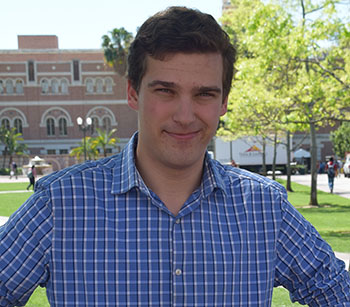
Zach Larkin
When Zach Larkin was 13, he sat down with his great-grandfather to interview and record his stories about his experiences as a Hungarian Jew during the Holocaust. Larkin didn’t know that this would begin his journey researching this time period and interacting with survivor testimony.
“[My great-grandfather] was a Holocaust survivor who didn’t like to talk about his experience with anyone, not even USC Shoah Foundation,” Larkin said. “But when I was 13, for some reason he talked to me and let me interview him and told me about his experience in Budapest in 1944.”
Larkin, a history major in his junior year at USC, is currently in HIST 446: Resistance to Genocide, taught by Professor Wolf Gruner, director for the USC Shoah Foundation Center for Advanced Genocide Research. Last semester, he took Professor Gruner’s class on comparative genocide and mass violence. As part of his work for the courses, he has extensively research the Hungarian Zionist youth movement, a group his great-grandfather was a member of.
Last week, Larkin gave a presentation to the USC Shoah Foundation Board of Councilors that began with his great-grandfather’s story. It ended, however, with another personal anecdote.
Just a few days before his presentation, Larkin was with his grandmother, who on a whim decided to contact a Holocaust survivor she hadn’t spoken to in two decades. Not only had the survivor, Sidi Glock, not changed her phone number, but she also conveniently lived just a few blocks away. Larkin and his grandmother went to talk to her and her brother, who happened to be Jean Greenstein, a man who Larkin had discovered, through the Visual History Archive, had been trapped in a wine cellar with this great-grandfather for three months.
“I never would have been in that room if it weren’t for my research, and I never would have known who this guy was if it weren’t for USC Shoah Foundation,” Larkin said. “That meeting brought a lot of academic clarity because I was able to ask him follow up questions that weren’t explored in the Shoah interview.”
"There’s so many stories about Hungarian Jews that it’s impossible to tell them in any one way."
Though this experience was unique, Larkin owes much of the work he has been able to do the Institute and the Visual History Archive, which he has used as his primary resource for his research on the Hungarian youth movement that saved tens of thousands of people. He believes the story is unique because it focuses on Jews as their own saviors, a story that is rarely told.
“It’s a story that’s not really well known right now because we don’t really talk about Jewish rescuers that much,” Larkin said. “We focus on the righteous gentiles.”
Larkin is hoping to bring more attention to these stories by developing them for television and film. He’s currently working on a romantic screenplay about how his great-grandfather rescued his great-grandmother during the Holocaust.
“There’s so many stories [about Hungarian Jews] that it’s impossible to tell them in any one way,” he said. “So I’m hoping creatively I’ll be able to bring these stories out in a relatable and meaningful way that isn’t just about any one person saving people, it’s more about this movement that has gone completely forgotten.”